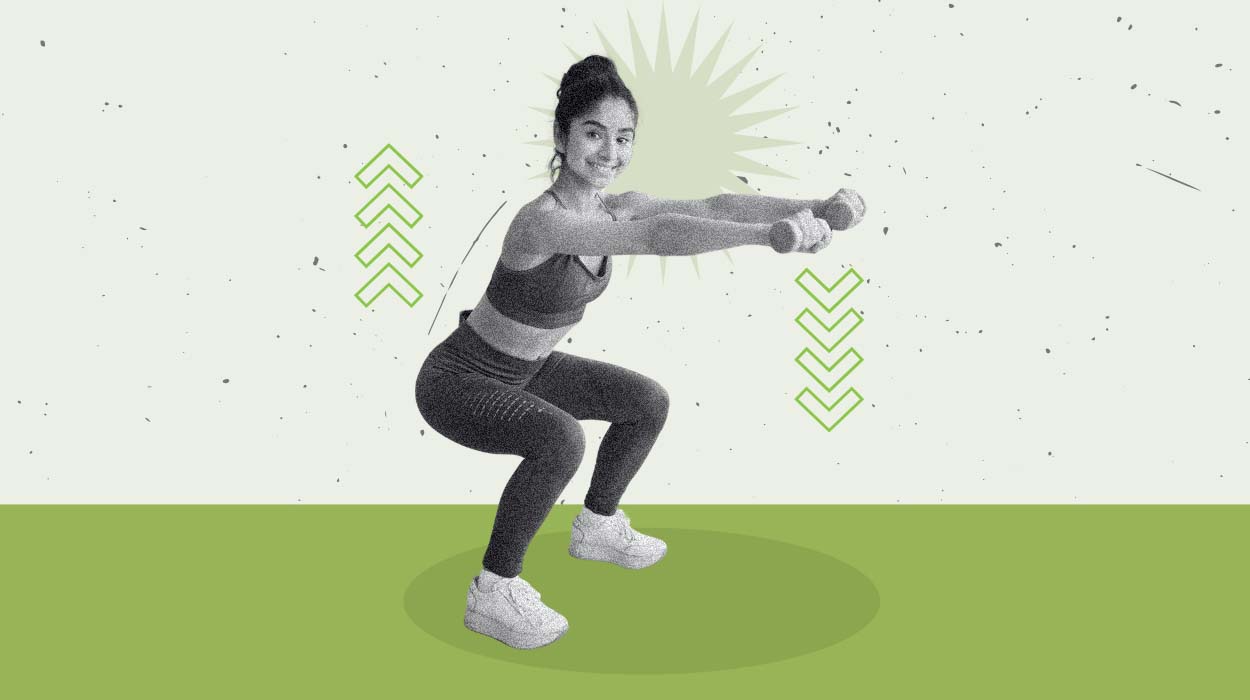
Squatting is a movement that is foundational to our daily lives. We squat when we’re getting in and out of a chair or picking up something from the ground and use a similar movement pattern when using stairs.
The muscles that are strengthened with squats are important for standing posture and endurance for running, walking, and sports. No matter the routine, three-day workout split or a five-day workout split, squats should be incorporated into anyone’s regular gym routine.
How To Do A Dumbbell Squat
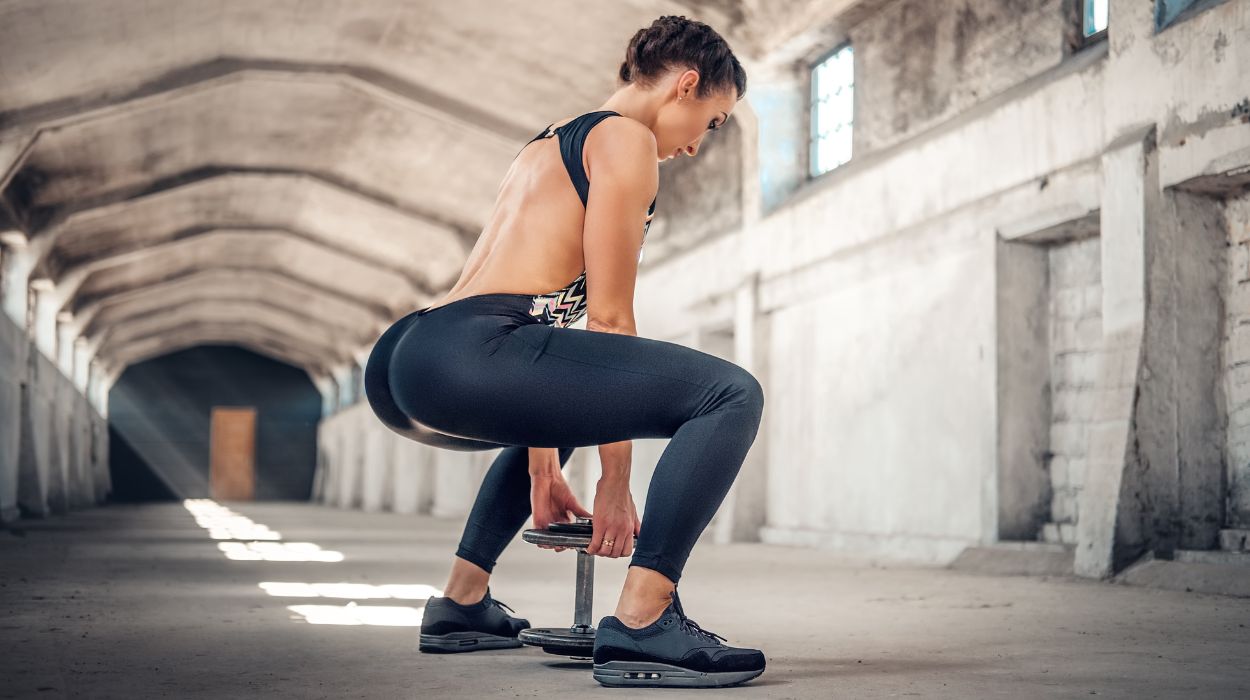
There are many ways to do dumbbell squats. How you hold the weight will affect body position and which muscles are working harder. However, a few things always stand true when squatting that you should be aware of.
Set Up Properly
Begin by standing with your feet shoulder-width apart. Hold a dumbbell in each hand at your sides, allowing your arms to hang naturally. Keep your chest up, and shoulders back, and engage your core muscles for stability. This is your starting position.
Perform The Squat
Initiate the squat by pushing your hips back and bending your knees. Lower your body as if you were sitting back in a chair, keeping your chest up and back straight. As you descend, make sure your knees track in line with your toes, and your thighs become parallel to the ground or as low as your mobility allows. Avoid letting your knees go beyond your toes to protect your knee joints.
Return To The Starting Position
Press through your heels and engage your glutes and quads to stand back up, extending your hips and knees simultaneously. Exhale as you return to the starting position. Maintain good posture throughout the movement, and repeat the desired number of repetitions.
Training Tips
Squats are quite technical and can be difficult to do with proper form. Here are some common dumbbell squat mistakes to be aware of next time you do them.
- Allow your knees to cave in. It is important to keep your knees in line with your toes while squatting and not let them cave in towards each other. Stable knees are less likely to get injured.
- Bend forward through your spine. Keep your shoulder blades pulled back to keep your upper back straight and keep your core tight to keep your lower back straight.
- Don’t jump right into heavy weight. Make sure you spend time warming up with less weight and slowly build up to a heavyweight.
Remember to start with a weight that allows you to perform the exercise with proper form. As you become more comfortable and confident, gradually increase the weight to continue challenging your muscles and making progress. Dumbbell squats are a versatile lower-body exercise that can be integrated into various workout routines to build strength in your legs, glutes, and core.
What Are Dumbbell Squats’ Benefits?
Dumbbell squats are a compound exercise which means that multiple joints are moving at the same time. Because they target so many muscles, they have several key benefits. First off, by using additional weight, you are challenging your body and making it adapt to having extra load. By continuously increasing the weight, you are preparing your body for higher impact activities such as jumping or running.
Lower body resistance training has been proven to even be an effective tool in reducing fall risk[1] in the elderly population. People with weaker muscles (no matter the age!) are less able to catch themselves if they fall and risk injuring themselves.
Squats make for shapely legs and glutes. Squatting with heavy weight will build strength and create desirable curvature throughout the lower body. Many people are scared they’ll become too big or bulky, but putting on muscle takes a lot of time (6-10 weeks!)[2], and you should be able to recognize if you’re gaining more muscle than you want to.
Six Dumbbell Squat Variations
Dumbbell Squat Variations offer a versatile and effective way to strengthen your lower body while adding variety to your workout routine. These variations also allow for greater customization to suit your fitness level and goals, making them valuable additions to any leg workout.
Traditional Squat
This exercise is a fundamental lower body exercise that targets your quadriceps, hamstrings, glutes, and lower back. It can be done with or without dumbbells. Its compound movement is an excellent addition to any workout routine, promoting strength, balance, and overall lower body development.
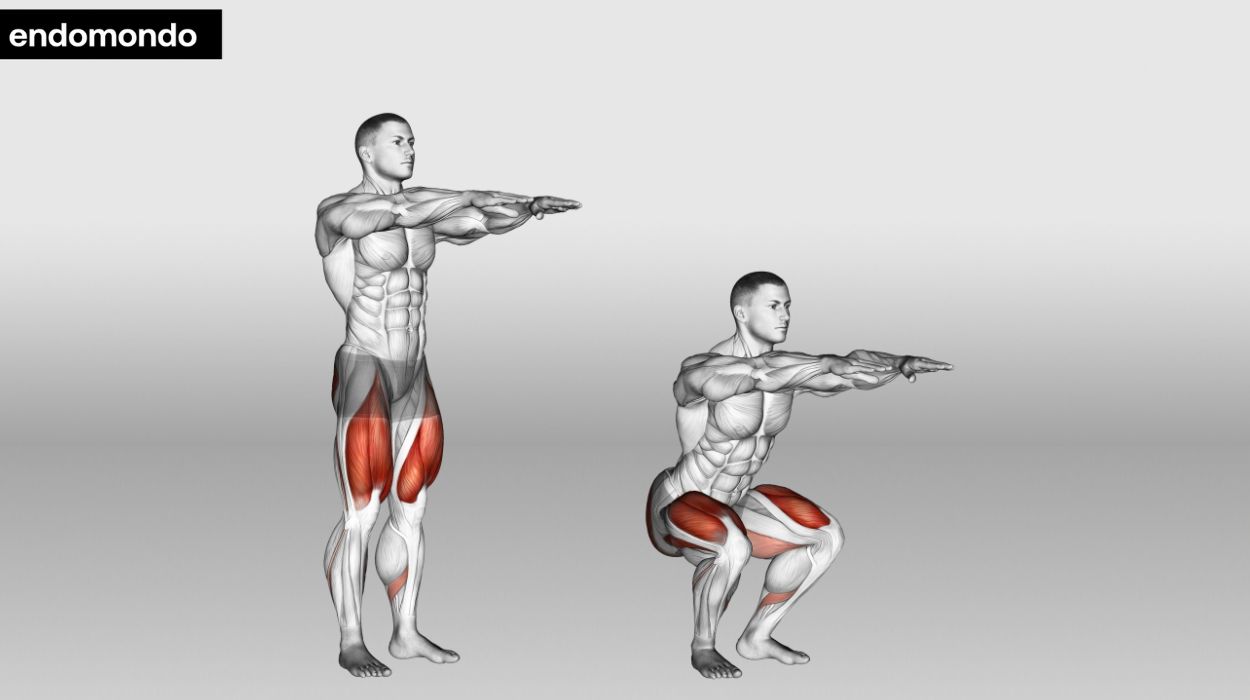
How to do:
- When using dumbbells, have one in each hand and let your arms hang by your sides.
- Your feet should be about hip-width apart to allow room for your arms.
- Sit your hips back and your weight evenly distributed between both legs as you lower yourself and only go as far as you feel comfortable.
- If you are doing bodyweight squats, you can keep your hands out in front of you or down by your sides.
Tips:
- Proper Form is Key: Maintain a neutral spine, keep your chest up, and push your hips back as you squat down to ensure proper form and prevent injury.
- Knee Alignment: Ensure your knees stay in line with your toes and avoid letting them collapse inward during the squat to protect your knee joints.
- Full Range of Motion: Descend until your thighs are at least parallel to the ground to engage your muscles fully. Going deeper can further enhance your squat’s effectiveness and mobility.
Optimal Sets and Reps: 3-4 sets of 8-12 reps
Dumbbell Sumo Squat
This exercise is a fantastic lower-body exercise that targets your quads, hamstrings, glutes, and inner thighs. For sumo dumbbell squats, you will use one heavy dumbbell. Incorporate this exercise into your routine for stronger, more defined lower body muscles.
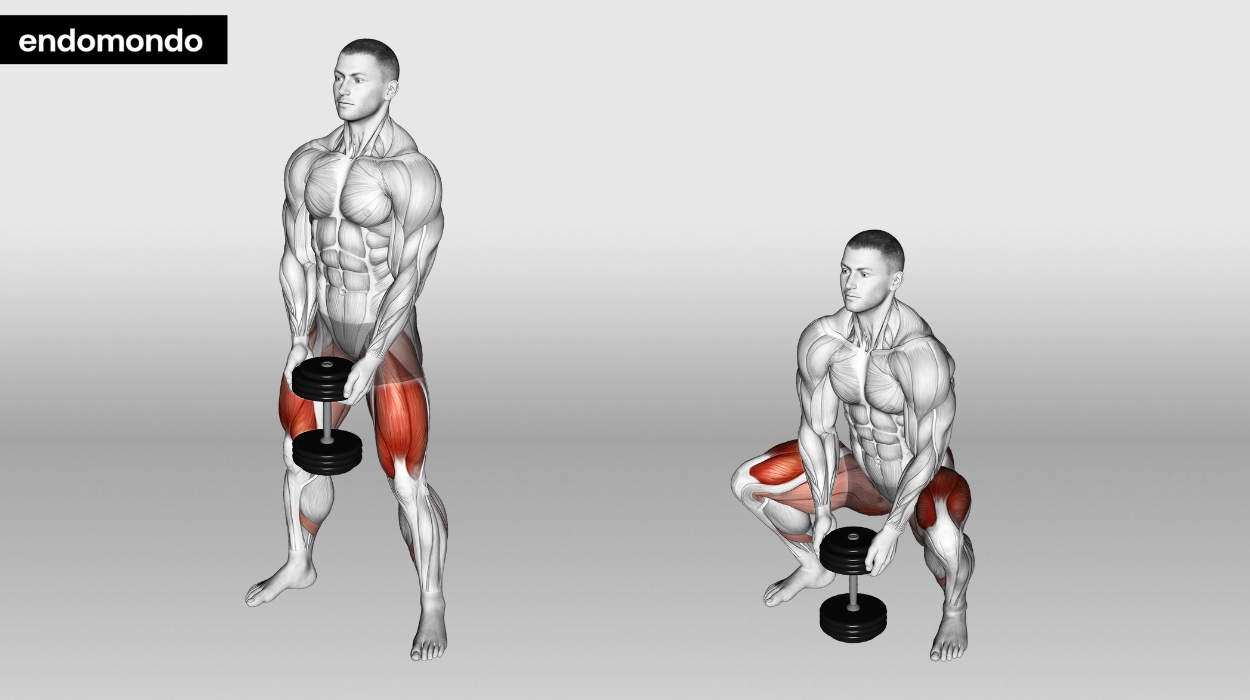
How to do:
- Your feet will be wider than shoulder-width apart, toes pointed out with the dumbbell directly in the middle.
- Sit your hips back and bend at the knees to come into a squat position and grab the weight.
- Hold the weight with your arms straight down in front of you and stand back up.
Tips:
- Wide Stance: Position your feet wider than shoulder-width apart, with toes slightly turned outward. This stance ensures you engage your inner thighs and activates your glutes effectively during the squat.
- Keep Your Back Straight: Maintain a straight back throughout the movement, avoiding rounding or arching. This not only helps prevent injury but also targets the right muscles, primarily your quads and glutes.
- Controlled Descent and Ascent: Lower yourself into the squat with control, keeping your knees in line with your toes. Push through your heels as you rise, focusing on the contraction in your glutes at the top of the movement.
Optimal Sets and Reps: 3 sets of 10-12 reps
Dumbbell Split Squat
This exercise is a fantastic lower-body exercise that targets the quads, hamstrings, and glutes while improving balance and stability. Additionally, the Sumo Squat can help improve your posture and core strength, making it a valuable addition to any fitness routine.
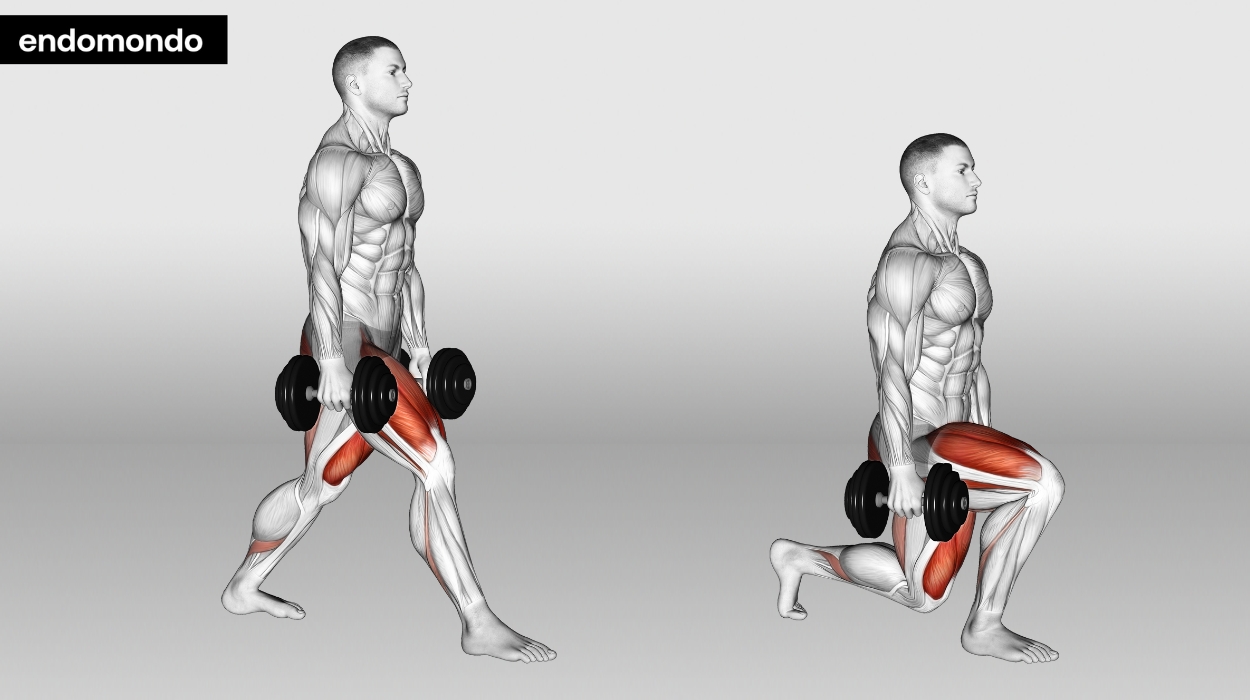
How to do:
- You will need two dumbbells for this variation, one in each hand.
- For your starting position, place one foot in front of the other as if you’re taking a long step.
- Let your arms hang by your sides while keeping your shoulders back and chest high.
- Bend through both knees to bring your body straight down towards the ground as far as you comfortably can go, then push up to the start position.
Tips:
- Maintain Proper Form: Keep your front knee aligned with your ankle and your back knee hovering just above the ground to ensure the safe and effective execution of the Dumbbell Split Squat.
- Engage Your Core: Stabilize your core throughout the movement to improve balance and protect your lower back. This engagement also helps you maximize the benefits for your leg muscles.
- Focus on Control and Balance: Control your descent and ascent, emphasizing balance and control over speed. This not only enhances muscle engagement but also reduces the risk of injury during the exercise.
Optimal Sets and Reps: 3 sets of 10-12 reps
Dumbbell Front Squat
This exercise is a fantastic compound exercise that offers a multitude of benefits. It targets your quadriceps, hamstrings, glutes, and core while improving lower body strength and stability. It also enhances your balance and flexibility, making it a valuable addition to any well-rounded strength training routine.
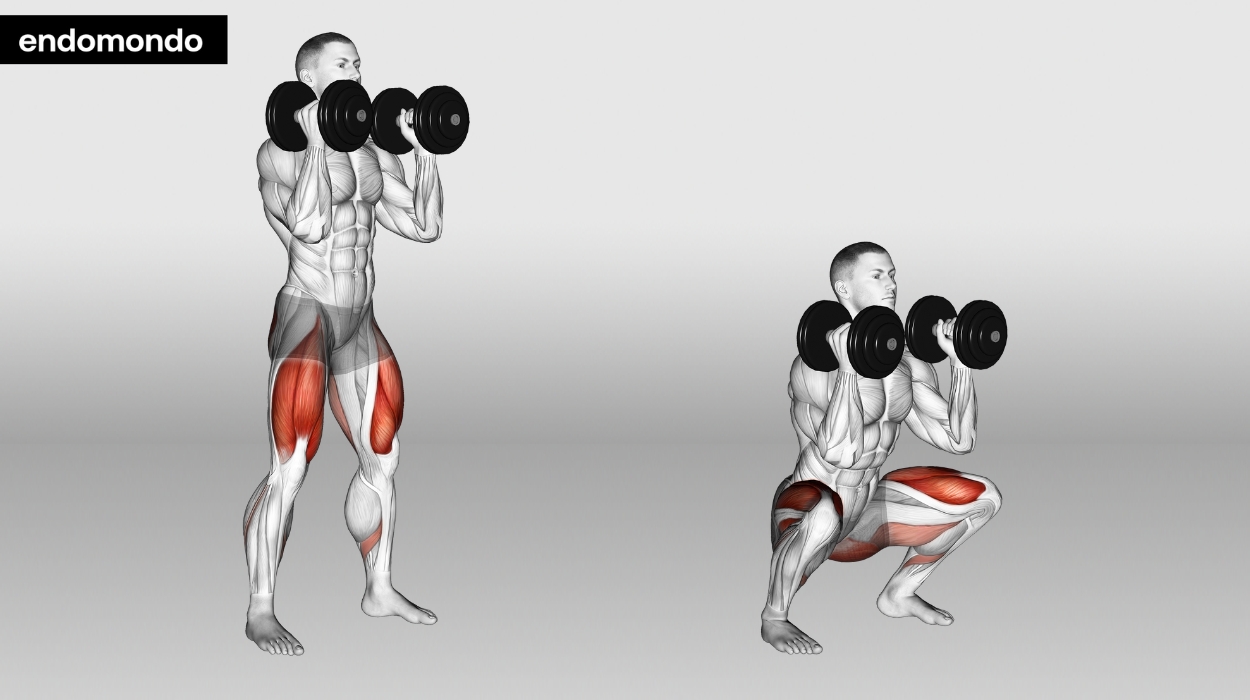
How to do:
- You’ll hold a dumbbell in each hand in a front rack position.
- The ends of the dumbbells rest on your shoulders and your elbows are pointed out in front of you.
- Keep your feet hip-width apart as you squat down.
- Due to the placement of the weight load, your upper body will stay more upright.
Tips:
- Proper Dumbbell Placement: Position the dumbbells at shoulder height with your palms facing forward. This supports better stability and minimizes strain on your wrists and shoulders during the exercise.
- Maintain an Upright Torso: Keep your chest up, back straight, and core engaged throughout the movement. This helps target your quads, hamstrings, and glutes effectively while reducing the risk of injury.
- Knees and Toes Alignment: Ensure your knees align with your toes during the squat to prevent stress on the knee joints. Push your hips back and down, keeping your knees in line with your second toe as you lower yourself into the squat position.
Optimal Sets and Reps: 3-4 sets of 6-12 reps
Bulgarian Split Squat
This single-leg movement helps improve balance and stability while targeting the quadriceps, hamstrings, and glutes, promoting strength and muscle development. Additionally, it reduces muscle imbalances between the legs, enhances functional fitness, and is versatile, as it can be performed with minimal equipment, making it an excellent addition to any workout routine.
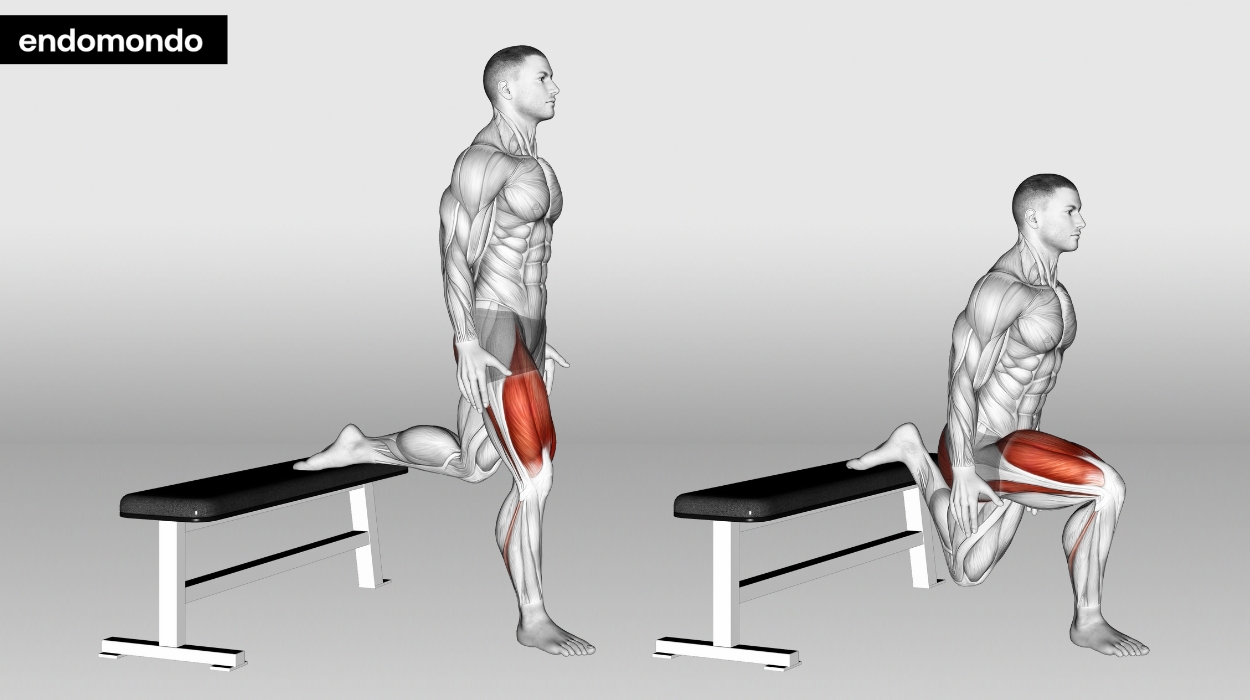
How to do:
- You will need a bench or Bulgarian split squat rack for this movement.
- One foot will be on the floor, the other will be placed with the laces down on the bench behind you.
- Hold a dumbbell in each hand and put most of your weight on the front foot.
- Drop down toward the ground as far as you can, then return to the starting position.
- By leaning forward, you will target the posterior chain muscles such as the hamstrings and glutes and by keeping your upper body more vertical, you will target the quadriceps.
Tips:
- Maintain Proper Form: Keep your front knee aligned with your ankle, and your back knee hovering just above the ground to ensure the right form. This prevents unnecessary strain and optimizes muscle engagement.
- Engage Your Core: Tighten your core muscles throughout the movement to stabilize your spine and maintain balance. This not only helps with proper form but also strengthens your core.
- Use Proper Foot Placement: Ensure your rear foot is on a sturdy surface like a bench or step. Your front foot should be positioned far enough forward to prevent your knee from going past your toes, promoting safe and effective movement.
Optimal Sets and Reps: 3 sets of 10-12 reps
Overhead Squat
This is one of the most difficult types of squats to master as you need great shoulder, spine, hip, and ankle mobility to perform this correctly. Additionally, the Overhead Squat helps build functional strength, making it valuable for athletes and individuals seeking to enhance their performance in various sports and daily activities.
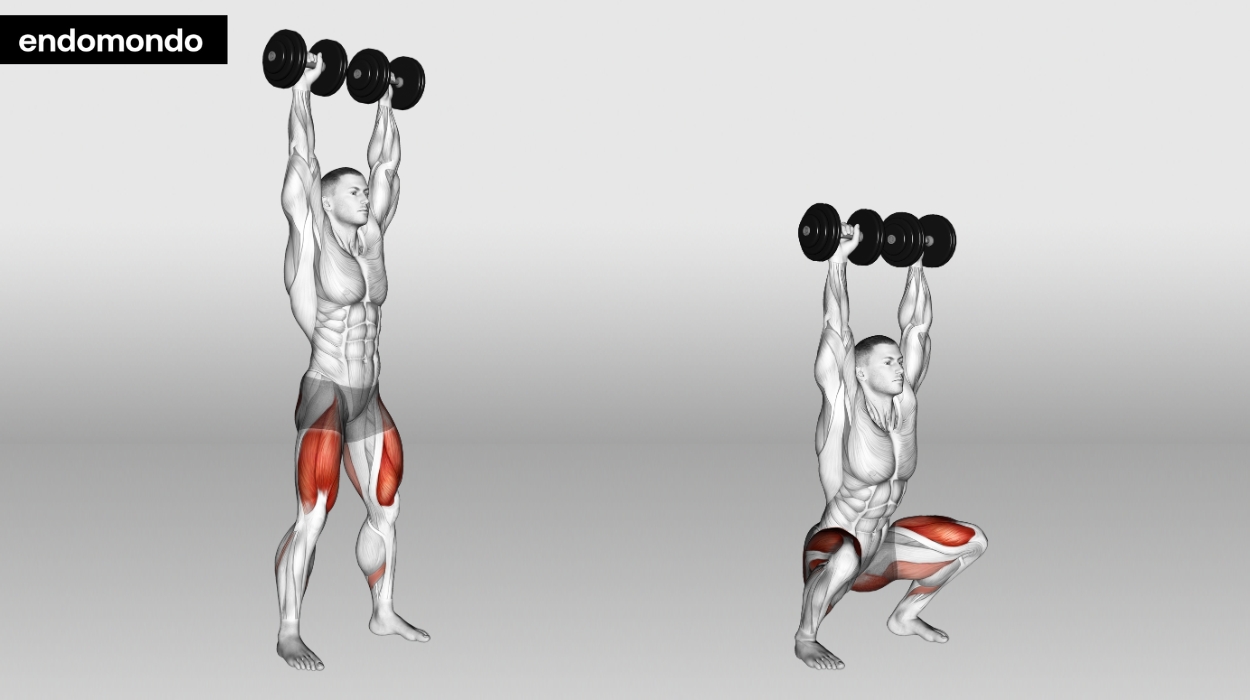
How to do:
- Start in a standing position. You will have a dumbbell in each hand.
- Perform a shoulder press so they are straight up in the air.
- Your feet should be about shoulder-width apart.
- Keep your chest high and your weight evenly distributed between your feet as you squat.
Tips:
- Master Your Form: Prioritize proper form and start with a light weight or no weight at all. Focus on keeping the barbell directly above your head, chest up, and knees tracking over your toes throughout the movement.
- Engage Your Core: Maintain a strong core by bracing your abs during the entire exercise. This not only protects your lower back but also helps with balance and stability.
- Progress Gradually: Increase the weight gradually as your form improves and you gain confidence. Over time, you can challenge yourself with heavier loads, but always prioritize safety and form over the amount of weight lifted.
Optimal Sets and Reps: 3 sets of 8-10 reps
Tips For Dumbbell Squats
There are many things to consider when squatting. Making sure that you incorporate a warm-up beforehand is important if you’re trying to use progressively heavier weights so your body can become accustomed to the weight load throughout subsequent sets. This means that starting with bodyweight squats might be your best option!
If you find that you are leaning forward a lot as you’re squatting, you may need to improve mobility in your ankles. Consult a physical therapist or personal trainer to see if this would be beneficial for you. Alternatively, you can use shoes with a heel lift or put your heels on a plate to reduce resistance that may be coming from your ankles.
Don’t neglect stabilizing muscles! Adding core and hip stability to your exercise program will help you progress over time. Exercises that improve balance such as single leg stance on an unstable surface, will also be useful in your weight lifting journey.
Conclusion
Dumbbell squats strengthen important muscles that are in the lower body. Stronger thighs and hips help with many activities from running to balance and can help keep your knees hips and back pain-free.
Frequently Asked Questions
Barbell squats are when you place the barbell either on your back or hold it in front of you in a front rack position. Dumbbells give you a little more freedom to explore new movements by holding the weights in varying positions. All squat variations target muscles in the thighs and hips.
There are many, but one major one is not maintaining a neutral spine. Squatting is a movement that should come from the legs only, while the spine and shoulders remain stable.
Yes! But only if it is pain-free. If you are experiencing knee pain with squatting, consult a physical therapist or personal trainer.
A: The best time to work out is whenever you can fit it in or when you feel the best. Everyone is different and some people like morning workouts while others enjoy evening workouts.
Yes, absolutely. The most important thing to remember is to work within your own ability. Here’s a workout routine for women to get started.
Resources
- Signorile, J.F. (2016). TARGETED RESISTANCE TRAINING TO IMPROVE INDEPENDENCE AND REDUCE FALL RISK IN OLDER CLIENTS. Acsm’s Health & Fitness Journal, [online] 20(5), pp.29–40. doi:https://doi.org/10.1249/fit.0000000000000238.
- Michał Krzysztofik, Wilk, M., Grzegorz Wojdała and Artur Gołaś (2019). Maximizing Muscle Hypertrophy: A Systematic Review of Advanced Resistance Training Techniques and Methods. International Journal of Environmental Research and Public Health, [online] 16(24), pp.4897–4897. doi:https://doi.org/10.3390/ijerph16244897.




